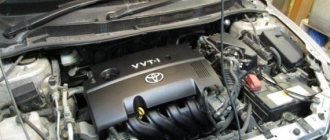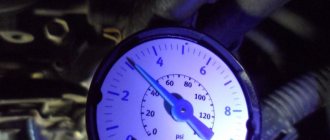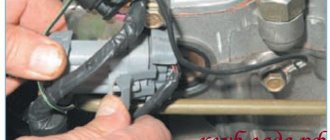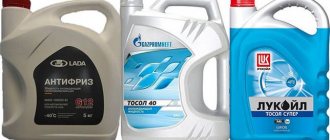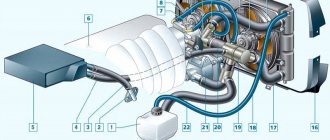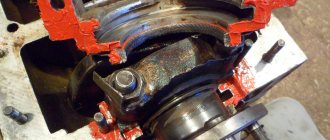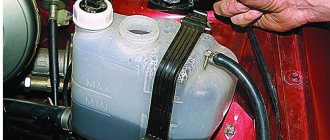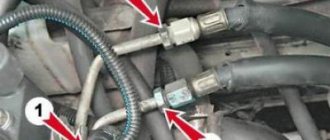Nowadays, the vast majority of passenger cars and specialized wheeled vehicles are equipped with internal combustion engines. Due to the fact that the design of modern engines is far from ideal, a good part of the energy produced is spent on removing heat from rubbing parts.
To do this, the engine is equipped with a liquid-air cooling system. It uses coolant (coolant), which, washing the jacket of the cylinder block, heats up and then, circulating in the radiator, cools under the influence of the oncoming air flow.
But the problem is that current engines heat up to very high temperatures during operation, and simple water in the cooling system will quickly turn into clouds of steam escaping from under the hood of the car. And even the use of antifreeze or antifreeze with a boiling point of 105–110 ° C is not a panacea. But designers have long come up with a way to alleviate this problem.
This can be helped by the pressure in the engine cooling system. Back in school we were told that increasing pressure increases the boiling point of a liquid. And so, thanks to this solution, the boiling point of the coolant was increased to 115-120°C.
Why is it important to maintain the correct pressure in the cooling system?
We have already partially touched on this issue above, but now we will consider it in a little more detail. Excessive pressure in the cooling system can damage the components that are involved in this system. This system includes a large number of elements that can simply tear or deform due to high pressure. These elements include:
Rubber hoses connecting parts of the cooling system;- Thermostat;
- Expansion tank;
- Water pump;
- Metal tubes suitable for radiators and engine;
- The radiators themselves, which are often made of aluminum.
If any of these components are deformed (or they are torn, broken, or cracked), the pressure in the cooling system is most likely to blame.
Read also: Why you should sleep at night and not during the day
( 391 votes, average: 4.50 out of 5)
How pressure is created inside a car's cooling system
The first thing you need to understand is that no special pressure is created in the engine cooling system. The engine units themselves do not care under what pressure the coolant circulates. The main thing is that the engine elements have time to cool sufficiently.
As you know, almost any liquid expands when heated. This also applies to coolant – antifreeze, antifreeze. On average, coolant expands by 10-20% when heated, that is, this is how much its level in the system increases. Since the cooling system is a closed, sealed circuit, pressure builds up when the engine starts and the coolant warms up. Antifreeze presses on the walls of radiators, pipes and other system components inside.
Please note: The expansion tank cap plays an important role in the car’s cooling system. It is a high and low pressure valve, which can, respectively, bleed off excess or, conversely, suck in air from the atmosphere.
Let's sum it up
So we figured out why there is pressure in the engine cooling system, why it can be excessively high or, conversely, low. There is often nothing complicated about checking it yourself, although a lot depends on the car. For example, it happens that the coolant temperature sensor fails. It can provide incorrect data to control devices, thereby misleading the driver. It can show both a high temperature of the power unit and, conversely, a low one. But this will not mean that the system is not working correctly.
If there are any breakdowns in the cooling system, they must be repaired as soon as possible. It is advisable not to operate a vehicle with a stuck cover or thermostat. After all, for some engines overheating is fatal, and major repairs are not cheap at all. In general, it is worth regularly checking the coolant level in the system to ensure that there are no leaks or other defects. It is also recommended to periodically clean the radiators from dirt, as this can cause increased engine temperature.
The problem is high pressure in the cooling system. The stove just burns (and it’s actually annoying). It all started in the fall, I began to notice that there was dampness from antifreeze around the cap of the expansion tank, I did not attach any importance to this, one fine day before checking I decided to look under the hood... the radiator around the perimeter was wet and there was a puddle under the car - the verdict was high pressure in the system. The radiator was replaced, the plug marked 0.9. After 2 months the situation repeats with a new radiator. The verdict in the service was the thermostat (what does it have to do with it), the thermostat was actually jammed in a half-open state, so thermostat + radiator + plug again... everything was bought new, except for the plugs (from disassembly for 150 rubles). After replacement - check, everything is OK, the thermostat opens, the large pipe to the radiator is soft, i.e. pressure is normal. Today I noticed moisture from antifreeze around the expansion tank cap again!!! The upper hose to the radiator is slightly swollen and pressure is felt. I changed the plug (this is the 5th contract plug), nothing has changed. The thermostat works, but...it's strange... It's -15 outside, active driving around the city with the climate control turned on at 27 degrees (while it's just hot in the cabin), I go out and touch the lower hose to the radiator - it's cold. I turn off the climate control and after a minute the thermostat opens. Is it really possible that the heater fan cools the engine to such an extent while the thermostat is closed - the fans do not work, the marking on the thermostat is 82. Based on the high pressure, there was an assumption that the pump was dying... but how... I checked the pump, I don’t know how correctly: I turned it off, turned on the ignition, climate control on HOT max, the air is getting colder and colder, I waited until it was completely cold, then I immediately started it - instantly the cold air turned into boiling water... So, I complained... Help what to do with high blood pressure...
Modern internal combustion engines are, to put it mildly, not ideal. They have very low efficiency , because part of the energy is simply “lost” to friction and heating. It is precisely because of heating that motors need to be cooled; now the most efficient system is liquid (although there was an air one). In it, the role of a cooler is taken on by a special liquid, usually antifreeze or antifreeze . It circulates in this system under a certain pressure, but what is it? I am often asked a question specifically about the pressure in the system - let’s figure out what it is and how it is formed there...
THE CONTENT OF THE ARTICLE
Such questions came after the article about the expansion tank cap , in which I indicated that this is, in fact, a high and low pressure valve, when necessary it bleeds off excess, and when necessary, on the contrary, it sucks it from the atmosphere, it’s interesting to read. But we have not yet decided what pressure is in the engine cooling system, say, when it is running, and also when it is stopped.
High blood pressure and methods of control
The cooling system is designed in such a way that the expansion tank cap is responsible for the pressure in it. Although there are various design options. For example, on some American cars, the expansion tank serves as a sump, and the cap itself is installed on the radiator tee. However, the essence of the work remains the same.
The pressure in the VAZ-2110 engine cooling system should be in the range from 1.2 to 1.5 atm, while a drop or exceeding of these values can already be considered a serious deviation. Quite often, motorists are faced with high blood pressure. The reason will be the same lid, the valve of which is stuck in the closed position. In this case, the system will warm up, the pressure will increase, but it will not be released. Because of this, steam-air plugs form, preventing the normal circulation of coolant through the system.
Serious consequences
We have already discussed that pressure is created in the engine cooling system. It's quite normal. Another thing is that very often there is a malfunction that is extremely difficult to determine. For example, the antifreeze goes away, but there is no visible leak. In this case, it is quite possible for coolant to enter the engine crankcase. It is recommended to check the oil level regularly. If the coolant actually goes into the engine, the level will increase. Most likely, this indicates a broken cylinder head gasket, changing which is tantamount to rebuilding the power unit.
Any part has its own specific resource, upon reaching which there is no guarantee that it will continue to work properly. There are often cases when even a new expansion tank cap turns out to be inoperative. And now we are not talking about Chinese spare parts, but about original ones. Unfortunately, there is no escape from this.
Why do you need high pressure inside the cooling system?
If you remember the school physics course, you can easily understand why increased pressure is used in the cooling system. As you know, the higher the pressure, the higher the boiling point of the liquid. Accordingly, if, for example, the pressure is 1 atmosphere, ordinary water will boil at 100 degrees Celsius. But, if you raise the pressure to 2 atmospheres, the boiling point will approach 120 degrees Celsius.
Please note: the example with water above is given for a reason. Until a few years ago, automobile cooling systems used plain water to cool the engine. Since its boiling point is at 100 degrees Celsius, and the operating temperature of the motor is often higher, it was decided to increase the pressure inside the cooling system. In addition, older cooling systems did not seal as well as their modern counterparts.
Coolants that are currently used in a car’s cooling system boil at a temperature of 130-140 degrees, and when in a sealed competition with high pressure, the temperature can reach up to 150 degrees. That is why the problem of engine “boiling” is becoming less and less common.
Normal parameters
It is difficult to say unambiguously what pressure should be in the cooling system of each car. Even on the same model with different installed internal combustion engines, the parameters may differ.
If we talk about average values, then this range is from 1.2 to 2 atmospheres. Although it is extremely rare that the indicators reach 2 atmospheres. But in the automotive industry there is an example when a pressure of 2.2 is considered the norm.
When calculating fluid pressure, the unit of measurement is usually Bars. But they are analogous to atmospheres. That is, 1 atm = 1 bar.
The internal pressure in an automobile cooling system depends on a number of factors. And not the least important role is played by what kind of coolant is poured into the radiator, what design the car’s engine has, its tightness and other nuances.
You can find out accurate information regarding the pressure level specifically in your engine from the manual and operating recommendations from the car manufacturer.
Causes of high and low pressure in the cooling system
Why is the blood pressure high?
Excessive pressure in the engine cooling system can occur for only one reason: an inoperative air valve in the radiator cap or expansion tank is stuck closed.
Since there is no other way to remove excess air, the serviceability of the valve must be checked periodically. Theoretically, this part cannot be repaired and if it fails, it is usually replaced along with the cover. Experts recommend replacing the radiator cap every two years to avoid sudden breakdowns.
Original spare parts
Very often, high pressure in the engine cooling system is formed due to a malfunction of the air valve, we have already dealt with this. Another thing is that this valve has an insufficient resource, or even a new one may not work. This also applies to other elements of the cooling system, such as a thermostat, water pump, pipes, sensors, radiators, etc. To sleep peacefully, it is better to get the original, the service life of which is often quite long. Of course, such spare parts cost several times more, but they almost 100% guarantee the proper operation of the unit as a whole. After all, the failure of such a seemingly insignificant element as a cover can lead to a major overhaul of the engine.
As for Chinese components, this is a lottery. Some of them can be quite high quality, while others do not travel even 100 kilometers. It’s better not to take risks, because the stingy pays twice.
Replacing a failed unit
The cooling system cap can last longer than the car engine, or you can buy a new one, which will be defective. It's hard to guess here. But in any case, you should not try to repair it. It costs a penny for most models and is non-repairable. In case of malfunction, it is simply replaced with a new one.
At the same time, it is strongly recommended not to shorten the springs by changing the moment of operation of the cover. After all, many motorists do this, which in most cases does not lead to anything good. Of course, if you have tuned the cooling system and engine, then it is quite possible that you need to achieve more pressure in the system or, conversely, less. In other cases, it is worth buying only the original or a worthy analogue with the same parameters. Remember that high pressure in the engine cooling system can lead to local overheating of the internal combustion engine and failure of certain components.
Valve performance check
Until the antifreeze heats up, the ball inside the lid closes the bottom hole, while the top one remains open. This is necessary for the flow of air from the atmosphere and rapid heating of the coolant. I would like to note that it is periodically necessary to check the functionality of the lid. After all, it often happens that it gets wedged in one of the positions. Because of this, the engine either takes a long time to warm up or does not hold pressure.
Checking the cap of the expansion tank of the VAZ-2110 is extremely simple. To do this, just unscrew it and shake it. If you can hear the ball dangling inside the housing, then the system is working and it is not jammed. Excessive pressure in the engine cooling system, as noted above, can lead to fatal consequences. Therefore, on modern cars the cover has two valves: inlet and outlet. Nowadays you can find lids on sale that operate at a certain pressure. But it is strongly recommended not to change the parameters set by the manufacturer.
Coolant
The manufacturer recommends using exclusively antifreeze as a coolant for the VAZ 2107. For the uninitiated car enthusiast, antifreeze and antifreeze are one and the same thing. Antifreeze is usually called all coolants without exception, regardless of where and when they were produced. Antifreeze is a type of antifreeze produced in the USSR. The name is an abbreviation for “separate laboratory organic synthesis technology.” Without exception, all coolants contain ethylene glycol and water. The differences are only in the type and quantity of anti-corrosion, anti-cavitation and anti-foam additives added. Therefore, for the VAZ 2107 the name of the coolant is not of great importance.
So is pressure a byproduct?
Not certainly in that way. The thing is that previously ordinary water was very often used in cooling systems. And as we know, it boils at 100 degrees Celsius, but only at normal pressure. Very often engines boiled, especially in summer, because it is quite easy for a motor to reach an operating temperature of 100 degrees Celsius! And the old systems cannot be called 100% sealed; air was sucked in a little.
What was done! A very, elementary and simple solution that saved it from boiling. They just took it and increased the pressure inside the system.
If you dig into physics, you get:
At 1 atmosphere - water boils at 100 degrees
At 1.5 atm. – 110 degrees
At 2.0 atm. – almost 120 g .
The cooling system was made hermetically sealed, it heated itself and created the necessary “atmospheres” inside. Thus, the water stopped boiling and simply cooled the engine. Simple and brilliant. To be fair, it is worth noting that modern coolants boil at higher temperatures, for example - often antifreeze can withstand 130 - 140 degrees, and if you also lock it in a sealed circuit, then all 145 will turn out! Progress does not stand still.
What role does the expansion tank cap play in the cooling system pressure?
An important issue that must be considered is the meaning of the expansion tank cap. It is a valve whose task is to control the pressure inside the hoses and pipes.
As engine temperature rises, the temperature of the fluid in the cooling system increases. Accordingly, the pressure increases along with this. If the system is not depressurized at a certain point, a hose or radiator may rupture.
The expansion tank cap is necessary to allow excess pressure to escape at the right time. In a similar way, it is possible to maintain a certain pressure inside the cooling system, for example, at a level of 1.5 atmospheres.
The expansion tank cap also plays a role in the opposite direction. When the car is parked, its engine gradually cools down. As the engine temperature decreases, the temperature of the coolant decreases, and at the same time a rarefied atmosphere forms in the cooling system. In such a situation, the expansion tank cap opens (that is, takes on the role of a valve) and supplies the required amount of air to normalize the pressure.
Tags
in the cooling systemcooling system.cooling system canin the cooling system cooling systemflush the cooling system cooling systemcooling system cooling system cooling system fast engine cooling system.equipped with engines internalthis engine is equipped with engine cooling.started the engine of your engine output from the engine itself quick cooling of the engine ZMZ the boiling point increases the solution boiling temperature engine temperature sensor as a result of thermal expansion. normal temperature balance increase the boiling point increase the response temperature
boilingwaterarticledegreesbeginsits celsius
What causes excess pressure
The problem of excess pressure in engine cooling systems has not completely disappeared, despite the introduction of new technologies. That is, the engine can still boil.
It is too much pressure and forced pressure on the internal walls that provoke all sorts of problems, including boiling. To prevent a malfunction in your engine cooling system, you need to quickly solve the problem.
You won’t have to look long for the reasons why there is excessively high pressure in the cooling system of a modern engine. You need to look for it in the steam-air valve mounted on the cover of the expansion tank used to fill the cooling liquid.
Sometimes the reasons lie in the expansion tank itself, which becomes jammed or clogged. But mostly the culprit is obvious. It is because of its loss of performance that too much pressure arises inside the engine, and this can greatly harm the cooling system.
The most correct solution in such a situation would be to replace the cover. There is simply no alternative. But since the valve cover is inexpensive, the car owner will definitely not go broke buying and replacing it.
Some people try to restore the valve when it is stuck due to contamination. For flushing, use liquid to clean carburetors. If this does not help and the increased pressure continues to persist in the cooling system, it will be better for your engine to purchase a new similar cap. Otherwise, don’t be surprised later why the engine boiled, the tank ruptured and serious and expensive repairs were required.
To maintain optimal operating condition of the cooling system, it is recommended to replace the valve cover every 2 years.
Excessive blood pressure is considered a more dangerous phenomenon than its deficiency. But even in this case there are some threats.



